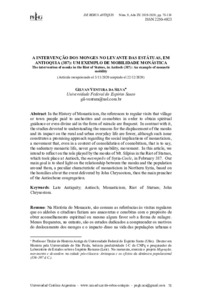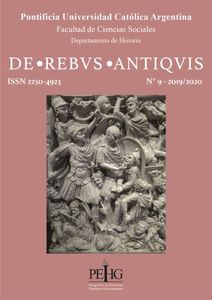Por favor, use este identificador para citar o enlazar este ítem:
https://repositorio.uca.edu.ar/handle/123456789/11694| Título: | A intervenção dos monges no levante das estátuas, em Antioquia (387) : um exemplo de mobilidade monástica The intervention of monks in the riot of statues, in Antioch (387) : an example of monastic mobility |
Autor: | Ventura da Silva, Gilvan | Palabras clave: | ANTIGÜEDAD; MONACATO; HISTORIA; Juan Crisóstomo, Santo, ca. 344-407; HOMILIAS | Fecha de publicación: | 2020 | Editorial: | Universidad Católica Argentina. Facultad de Ciencias Sociales. Departamento de Historia | Cita: | Ventura da Silva, G. A intervenção dos monges no levante das estátuas, em Antioquia (387) : um exemplo de mobilidade monástica [en línea]. De Rebus Antiquis. 2020, 9. Disponible en: https://repositorio.uca.edu.ar/handle/123456789/11694 | Resumen: | Resumo: Na História do Monacato, são comuns as referências às visitas regulares que os aldeões e citadinos faziam aos anacoretas e cenobitas com o propósito de obter aconselhamento espiritual ou mesmo algum favor sob a forma de milagre. Menos frequentes, no entanto, são os estudos dedicados a compreender os motivos do deslocamento dos monges e o impacto disso na vida das populações urbanas e rurais, o que representa uma promissora via de interpretação acerca das implicações sociais do monacato, movimento que, mesmo num contexto de afirmação do cenobitismo, ou seja, da vida monástica sedentária, nunca prescindiu da mobilidade, do movimento. Nesse artigo, temos por intenção refletir sobre o papel desempenhado pelos monges do Monte Sílpios no Levante das Estátuas, que ocorre em Antioquia, a metrópole da província da Síria-Coele, em fevereiro de 387. Nosso principal objetivo é iluminar a relação de solidariedade dos monges com a pólis mediante a exploração da série de homilias sobre o episódio pronunciadas por João Crisóstomo, o principal pregador da congregação antioquena à época. Abstract: In the History of Monasticism, the references to regular visits that village or town people paid to anchorites and coenobites in order to obtain spiritual guidance or even divine aid in the form of miracle are frequent. In contrast with it, the studies devoted to understanding the reasons for the displacement of the monks and its impact on the rural and urban everyday life are fewer, although such issue constitutes a promising approach regarding the social implications of monasticism, a movement that, even in a context of consolidation of coenobitism, that is to say, the sedentary monastic life, never gave up mobility, movement. In this article, we intend to reflect on the role played by the monks of Mt. Silpius in the Riot of Statues, which took place at Antioch, the metropolis of Syria-Coele, in February 387. Our main goal is to shed light on the relationship between the monks and the population around them, a peculiar characteristic of monasticism in Northern Syria, based on the homilies about the event delivered by John Chrysostom, then the main preacher of the Antiochene congregation. |
URI: | https://repositorio.uca.edu.ar/handle/123456789/11694 | ISSN: | 2250-4923 | Disciplina: | HISTORIA | Derechos: | Acceso abierto | Fuente: | De Rebus Antiquis. 2020, 9 |
| Aparece en las colecciones: | DRA - 2019-2020 nro. 9 |
Ficheros en este ítem:
| Fichero | Descripción | Tamaño | Formato | |
|---|---|---|---|---|
| intervencao-dos-monges-levante.pdf | 392,54 kB | Adobe PDF |  Visualizar/Abrir | |
| cover_issue_346_es_AR.jpg | 1,99 MB | JPEG |  Visualizar/Abrir |
Visualizaciones de página(s)
84
comprobado en 30-abr-2024
Descarga(s)
51
comprobado en 30-abr-2024
Google ScholarTM
Ver en Google Scholar
Este ítem está sujeto a una Licencia Creative Commons

